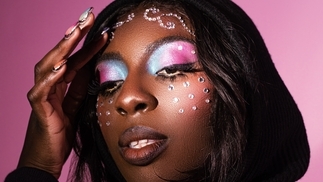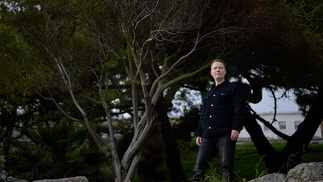AUDIO INTERFACE: DJ MAG MEETS HESSLE AUDIO FOR OUR MAY UK COVER
Hessle Audio, the label run by Ben UFO, Pearson Sound and Pangaea, has just reached its 10th anniversary milestone.

Initially bonding over the infinite possibilities of the embryonic dubstep scene in the midnoughties, the trio soon set off on their own tangents. Launching Hessle Audio together in 2007, their outsider take on club music has helped reshape the scene during its various twists and turns over the past decade. The three have very distinct musical identities, yet when they come together as A&Rs or as DJs something very special happens. As the threesome embark on a tour to mark the label’s 10th birthday, DJ Mag meets them in South London...
Words: BEN MURPHY Pics: CARSTEN WINDHORST
There’s a lot of people pushing old drum machines or reissuing drum machines now,” says Kevin McAuley, aka Pangaea, one-third of the pioneering Hessle Audio crew. “It feels like things are being marketed towards making classic sounds. There’s nostalgia everywhere, ’cause it’s comforting for people. But dance music should be forward-thinking.”
Hessle Audio has always looked to the future. This label, set up by Pangaea, Pearson Sound (David Kennedy) and Ben UFO (Ben Thomson) has remained at the vanguard from its very first release 10 years ago.
While some electronic producers, with their fetishizing of analogue gear and old school authenticity, are stuck in a vintage vacuum, Hessle Audio’s three pioneers — and the artists they’ve released on their label — have consistently pushed boundaries. Operating on the fringes of genre, they’ve changed the course of underground dance music more than once, indicating new pathways for dubstep, house, techno and beyond. In 2017, they’re celebrating a decade of operation with a big European and US tour. The tour has them playing back-to-back-to back all night and represents a consolidation of the trio’s powers. They’ve become a main draw without once compromising their independence or fearless musical aesthetic.
Ben UFO has earned a reputation up there with the best underground DJs in the world. With no compulsion to produce tracks (a rarity in today’s scene), his daring sets travel from grime to techno to house, indefinable bass music and myriad experimental oddities besides, all transmuted and linked together with a unique dancefloor attitude. Pangaea’s psychotropic productions have been melting minds since 2007. Atmospheric in the extreme, spacious and strange, each of his tracks comes loaded with bass weight. A 2014 Fabric mix showcased his formidable DJing chops, while last year’s techno-heavy ‘In Drum Play’ (on Hessle) demonstrated a remarkable merging of experimentalism with club nous.
Pearson Sound’s productions are always eagerly awaited. Foxing expectations with each release, he’s as comfortable making garage-loaded house (‘Your Words Matter’, with Midland, released on Aus) as he is cone-rattling IDM strangeness (‘Gristle’, from his 2015 ‘Pearson Sound’ album) or sinister, cinematic techno (club hit ‘Thaw Cycle’, on his own Pearson Sound label).
Though each of the three has their own areas of musical interest, it’s the convergence of their ideas, and a belief in pushing forward, that defines Hessle Audio and makes them stand out.
CHIPPER
DJ Mag meets them one sunny spring morning in south-east London, near where Ben UFO lives now. After weekend gigs, they’re remarkably chipper. Ben tells us about some grime record collections he bought recently nearby, and we stroll to a quiet café for the interview. Each of them talks with great conviction and a natural camaraderie. They speak frankly on all subjects, from their recollections of how they started out in dance music, to how they perceive their label now.
“Our whole thing has been about trying to look forward, to release new music by new producers, so we don’t want it to feel too heritage, or too much like a victory lap,” says Ben of the 10-year milestone. “We’re releasing stuff and want to have an active year, that seems like the best way to celebrate it.”
“We’re trying not to turn it into too much of a heritage thing. Like, 10 years and now it’s all downhill!” jokes David. Ever since the label’s start in 2007, Hessle Audio has been an outlet for cutting-edge electronic beats and bass. It’s become a go-to, buy-on-sight imprint for DJs. With each release, a delicate balance between experimentalism and club heft is struck. Records that have stood out for their otherness, from TRG’s techy, smudged garage track ‘Broken Heart’ to Untold’s weird, sinuous grime cut ‘Anaconda’ via the percussive what-do-you call-it beats of Joe’s ‘Claptrap’, have also proven to be invaluable weapons in any serious DJ’s arsenal, across all genres. “What we sign has to be something that works in clubs,” says Kevin. “There’s a lot of music out there that is headphone music, or interesting electronic music, I’m certainly feeling that at the moment. But the first thing I’m listening for is, ‘Will I be able to use this in a club?’ It doesn’t necessarily have to be something that is an obvious club tune, but say Bandshell’s record, ‘Dust March’, for me is such an amazing track to play in a club, it just sounds incredible.”
“Joe is definitely on the fringe,” says Ben. “‘Claptrap’, at the time [it was released in 2010], sounded totally mad, and completely his own. But at the same time, everyone played it. People in dubstep and grime played it, people in the house world played it, pitched right down. It’s the track we’ve released that’s been played in the most different contexts, but at the same time it’s one of the weirdest. That’s the dream, we’ll be lucky if we find another record like that.”
In the last 10 years, Hessle Audio has released many early records by future stars, the most notable of whom, James Blake, now makes quite different productions for US pop and hip-hop champs Beyoncé and Kendrick Lamar. Singles by Blawan, Objekt and the aforementioned Untold have shone alongside Pangaea and Pearson Sound’s (formerly Ramadanman) own releases, and all this has been achieved without outside interference or troubled by profit margins.
“We never took that step of employing anyone else,” Ben says. “We never had anyone to come in and help with anything, let alone employ a label manager or anything like that. The only people we’ve had to satisfy are ourselves. We’re living primarily from DJing, so we’ve never had to rush ourselves or put anything out we’re unsure about. We can look back on the last 10 years and feel really intimately connected to everything we’ve released.”

DRUM & BASS
Ben, David and Kevin formulated the idea for Hessle Audio while studying at Leeds University. The first two, originally from London, bonded with Kevin, originally from a village near Swindon in the south-west of England, over an appreciation for drum & bass DJ Bailey’s 1Xtra radio show. Each of them, though, had quite a different musical background.
Ben’s dance music beginnings were at the deep end of d&b, which he’d hear at club-nights in a now defunct London venue. “I was buying drum & bass, that was when I learnt to mix,” he says. “There were these little parties going on in East London at a venue called Herbal, put on by the labels Bassbin and Inperspective. They were Wednesday night parties. People were interested in dubstep there, too. There were all these producers like Amit that you used to see down at the early DMZs as well, so there was a bit of an overlap. I think that was a general pattern, where there was a dissatisfaction with the wider drum & bass scene, and a desire to try to find something else.”
Kevin, conversely, got into dance music the way many teenagers first experience it. “I was buying trance and hard house,” he says. “It was stuff from HMV. These were, like, £3.99 singles on labels like Tidy Trax. It was just what I had access to.” David says of his own route into dance music, “I was making some grime-style instrumentals and posting them online, and I seem to remember someone saying, ‘This isn’t really grime, it sounds like dubstep’. This must have been late 2005. I was like, ‘What’s this dubstep thing?’ It was about the time that there was all this hype that Mary Anne Hobbs was gonna broadcast a new show in January 2006 [Dubstep Warz on BBC Radio 1]. I listened to that and got fully stuck in, really. I heard about dubstep just at the right time, before it got this exposure. Before grime, I was listening to drum & bass, some of the more commercial stuff like Pendulum, and a lot of house and deep house. It wasn’t until I got into dubstep that I became really single-minded about one genre.”
Dubstep was the genre that brought the three together. They became obsessed with its possibilities, its lack of musical boundaries, and welcoming though small scene. “It was totally fresh to me,” Kevin recalls. “Very new and very exciting. It felt like you could be a part of it in ways you might find it hard to with other genres. I was producing bits and bobs before, but it was when this came along that it felt it was speaking to me. It felt innovative.”
Pangaea and Pearson Sound were producing tracks, and all three began doing their own radio show playing dubstep tracks on respected internet station Sub FM. “Kev and Dave could write a record, send it round to people who were the biggest DJs and producers in the scene at the time, and you’d almost always get a response,” Ben says. “They’d probably hear it.”
It was the internet, all agree, that had a significant role to play in the growth of dubstep and its rapid evolution. “It was a perfect storm, the first scene to break through the internet,” David says. “Grime was earlier in that respect and did have some stuff going on on the web, but it wasn’t until dubstep came about that the wave of the internet suddenly became massive. It was maybe the last scene to exist between those two worlds.”
DUBSTEP
Despite their early involvement in dubstep, the Hessle Audio three existed outside the inner sanctum. Having arrived on the scene after it was becoming established, and with their diverse influences, they found themselves drawn to tracks that didn’t necessarily fit the dubstep template of the time. Inundated with high-quality demos of stranger stuff that strayed from the norm, they played those too amidst more traditional material on their Sub FM show.
“We always wanted to contribute to scenes, to be part of things,” Ben says. “We wanted to contribute to dubstep and help shape that music, but because we weren’t part of that first wave, we were coming at it from a slightly different angle.”
These different kinds of tracks they’d play on Sub FM would be the catalyst for starting the label. “We were getting sent loads of music, stuff like TRG which sounded very different to what was being released at the time,” David says. “I thought, ‘This music doesn’t have a home, we’re being sent it, unreleased as demos’...
“At the time we started the label, that half-step, dubstep rhythm was super-dominant. Older garage roots weren’t being played out or released, so when TRG came with these retro two-step tracks, updated, it felt like a good way to make an entrance. Like, ‘OK, this is something unusual and interesting sounding, compared to what was prevalent at the time in the scene’.”
After the first TRG release, ‘Put You Down’, releases from Pangaea, Untold and Ramadanman (Pearson Sound) quickly followed. Inspired by the DiY ethos of Mala’s Digital Mystikz (DMZ) label, Hessle Audio quickly established its own independent aesthetic. Some would tag these records, which incorporated everything from hazy dub techno to two-step garage, as post-dubstep, but the label quickly moved on, resisting tags, putting out weird, wonderful tracks such as Joe’s mechanistic body slammer ‘Maximum Busy Muscle’, the psychedelic broken electro of Objekt’s ‘Porcupine’ or the vivid, colour wheel bleeps of Bruce’s ‘Not Stochastic’. A greater appreciation for techno is evident in Hessle Audio’s most recent releases, though certain core characteristics — heavy bass, hypnotic, unusual synth sounds and an emphasis on functional rhythms, however skeletal — tend to define the label’s output.
Ultimately, the tracks must meet with the approval of the varied tastes of the three label owners. “We don’t tend to A&R too heavily, most of the time people are coming to us with something fully formed already,” Ben says. “With the Bruce one ‘Not Stochastic’, that was in the first pack he sent us. We signed it ’cause I played it on the radio [on the Rinse FM Hessle Audio show], and Kev happened to have Rinse on in the kitchen. He sent me a text saying, ‘What the fuck’s this?’”
BASS-HEAVY
Ben points out that tracks signed to the label must be functional, but not in a pejorative sense. “In house and techno, when people talk about functional club music, it almost has negative connotations, as though that music has to be straight or fit narrow parameters, but I think dubstep shaped the way we think about functional club music a lot more, ’cause it was music rooted in soundsystem culture. So it was interesting, brave music, but it was music primarily to be listened to incredibly loud. Function to us means something a bit warmer and a bit nicer.”
Just as Hessle Audio is now known for its unpredictable — but always thrilling — tangents, so Ben’s DJ sets mirror the label, challenging clubgoers to keep up with his rhythmic diversions across styles, and sometimes into abstract territory. “It’s quite interesting trying to test the limits of what’s club-appropriate, finding what that line is,” he says.

As part of their on-going tour this year, Hessle Audio have already played some unusual venues they’ve not visited before, like Bassiani in Tbilisi, Georgia (“It was astonishing, such a good venue,” David says), and are looking forward to playing Concrete in Paris, Robert Johnson in Offenbach, Germany, and a festival in Japan called Rainbow Disco Club. Part of their intention with the tour is to mix up the kinds of venues they’ll be playing. “We started the tour in Ramsgate Music Hall, a small venue which is basically a dark room with a really good soundsystem. Switching things up. It wouldn’t be that interesting if we did a regular run of the usual suspects. It’s the balance of the two that is important.”
They’ll be tailoring their sets to each venue. While Tbilisi was primarily techno, other clubs will get a more bass-heavy approach. “All our interests are so different, there’s so much variety, that it’s quite apt to be playing quite a lot of different venues and different sizes of clubs,” Kevin says. “It’s kind of what the label’s about. We can play a big techno club for nine hours straight or we can play Ramsgate on a Thursday, or on a big reggae soundsystem.”
“The gig that we were going to be doing at the West India Centre is now at a venue called Freedom Hills in Leeds,” Ben says. “That’s playing for promoter Simon Scott, who has been a supporter of ours for more than 10 years. That’s on the Iration Steppas soundsystem, I’ve not played on there before, but it was the sound used for a lot of the early dubstep parties up in Leeds that we were all at, so the focus there will be a bit different.
“At some of these shows we’re booking the younger guys as well and wanting to bring people out and about with us,” he continues. “It felt like such a big deal to be playing on the Iration system and I knew it would be a big deal for some other people too, so we invited Bruce and Beneath to play. It’s a nice way to shape what we’re doing.”
The shows are an opportunity for each of the DJs to explore and combine their personal tastes across eight- or nine-hour sets, using a mixture of CDJs and, if the club has a decent set-up, vinyl.
“The best thing about us doing it with the three of us,” Ben says, “is someone will play something that sends us off on a tangent, and it helps keep the whole thing moving. If we were doing those shows and those venues solo, perhaps it would be a bit more one-directional, but it’s nice that everything is in flux when we play together. You don’t know what’s going to happen next, it’s nice.”
“Eight or nine hours is a long time, so it’s good to have a rest, go out and see what’s happening in the crowd,” David says.
TECHNO
The tangential tastes of Ben, Kevin and David, as often as they converge, have taken them in some novel directions recently. Pangaea’s excellent album ‘In Drum Play’, despite occasional nods to galactic grime and breakbeats, affirmed his drift towards techno. Like recent releases on his own HADAL label, ‘In Drum Play’ simmers with inventive four-four techno tracks. The juddering, metallic ‘Rotor Soap’ sounds like a factory in overdrive, while the sinuous, double-jointed ‘More Is More To Burn’ pivots on a balletic, entrancing synth figure and rough kicks.
“What’s the move to techno inspired by?” Kevin grins conspiratorially. “Dancing in clubs for a long period of time. It’s like what I was saying before about hard house and trance, it’s always been in me, I loved that stuff at 14 or 15, it was so good. It’s been a thread in my music, even if it’s been spaced-out dubstep from the early days. At some point it came that I was going out more to techno clubs, Berghain and places like that. I identified more with that side of music for whatever reason. What I make is always a bit skewed anyway, but I’m thinking more along those lines.
“There came a point when I was playing more techno, but I wanted to make stuff I could play in techno sets as well. It felt very natural to me,” he continues. “The last few years have been a transition of me trying to find my way or what I wanted to do, and what I’m doing now feels like I’m within this Hessle sphere. It’s related to that, but it’s on my own terms.”
David, conversely, stepped away from pure club fare with the release of his debut ‘Pearson Sound’ album in 2015. Though it featured several dancefloor-focused tracks, it also had downtempo gems like the atmospheric electronics of ‘Six Congas’ and the fractured beats of ‘Swill’. This shift towards IDM, David says, happened intuitively. “I feel like I’ve always made whatever I wanted,” he tells DJ Mag. “In 2010, say the house tracks I made with Midland or Appleblim, they might have been unexpected at the time. I’ve always felt like I don’t have to sit down and write a dubstep track. “When it came to the album, it was quite nice how that came about in terms of being focused on a particular mood or style,” he continues. “It came together very naturally, which hadn’t really happened before in terms of wanting to do a bigger piece of work like that.”
For those thinking he’d abandoned making dance beats, David quickly countered with bona fide bangers ‘Thaw Cycle/Freeze Cycle’ and ‘XLB’, two singles that combined the avant-garde with a razor-sharp dancefloor sensibility. “The album was definitely more on the heads-down side of things, which I guess is partly why since then I’ve released a few more dancefloor tracks, ‘Thaw Cycle’, ‘XLB’. I didn’t want to go fully down the self-indulgent IDM route. I needed to get it out of my system.”
Ben’s focus remains on DJing. Rather than feel forced to make tracks of his own, he says he must stay one step ahead in his chosen profession. Proof of his dedication can be found on his mixes for Fabric and Rinse — and at his very frequent gigs around the world.
“I feel more pressure just to be a good DJ. Especially now,” he says. “When I came through, the default tag-line for the journalist was, ‘This is the guy who does this thing without having any tunes’, and I guess people just take that for granted now. But I think it just led to me taking the focus completely away from any of that stuff and being as good a DJ as I can possibly be.”
FRINGES
It’s Hessle Audio’s resistance to conformity, and their celebration of difference, that really sets them apart. Coming at dance music from the fringes, the Hessle Audio crew have gained an advantage, and have reshaped club culture to their own ends.
“Coming to music as a bit of an outsider is a common thread [for us],” Ben says. “It’s like coming into techno as something that was big and established, for me anyway. Not really knowing very much about it. Just buying records that I was coming across and enjoying them, wanting to DJ them. It’s kind of wicked, you end up making decisions that people that know that music better wouldn’t come to. It might be counter-intuitive to people completely immersed in that music.”
Coming up on Hessle Audio, there’s an incredible new EP by Bristol’s Batu (who runs the Timedance label) — lurching from the futuristic sound design, bass and ambience of ‘Don’t’ to the next-gen Sheffield bleep of ‘Off Court’. There are also further releases in the works, but the trio are reluctant to talk about them just yet. Their game-plan for now is to keep doing what they’ve always done: looking to the future. “The ideal is we’ll carry on finding music that doesn’t make sense anywhere else,” Ben concludes. Amen to that.
A decade of essential tunes
TRG ‘Broken Heart’ 2007
On the flipside of the track that launched the label, ‘Put You Down’, was this essential cut. When it first dropped, with its dub-tech clangs, dislocated two-step beats and lethal subs, there was nothing else like it.
Pangaea ‘Router’ 2008
With its haunting, mournful vocal sample (“This is how I feel”), minor chord stabs, and scuttling garage beats, ‘Router’ still stands out a mile.
Untold ‘Anaconda’ 2009
A hybrid of grime, dubstep and skeletal rhythms, the blips, warping bass and spring-loaded energy of this oddity made it as deadly as its namesake, ensuring the track crossed over into the sets of the most adventurous techno DJs too.
Ramadanman ‘A Couple More Years’ 2010
On a diverse EP of next-gen dancefloor cuts (the ‘Ramadanman’ EP), ‘A Couple More Years’ was the highlight: a thrilling collision of stopstart breakbeats and grime bass.
Peverelist ‘Dance Till The Police Come’ 2011
From another forward-thinking producer originally associated with dubstep, came this synth-led, ravey broken techno beast. Invention and club gold rolled into one.
Objekt ‘Porcupine’ 2012
He’s a key player in today’s underground dance scene but back in 2012 Objekt was a fairly new name. ‘Porcupine’, with its skittering electro beats and grand, spacious chords, broke the mould.
Pev & Kowton ‘Raw Code’ 2013
A stripped-down, dubbed-out, broken techno missive from two of the best in business.
Bruce ‘Not Stochastic’ 2014
Like Brion Gysin’s trip-inducing, stroboscopic Dream Machine on wax, this swirling piece of electronics was a key weapon in Hessle Audio’s armoury.
Pearson Sound ‘Six Congas’ 2015
Engrossing IDM from David Kennedy, stepping away briefly from his dancefloor material.
Pangaea ‘Lofty Can’ 2016
From the ‘In Drum Play’ album came this killer percussive piece, cutting up familiar breakbeats in alien ways.





